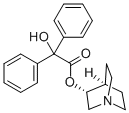R(-)-퀴누클리디닐벤질레이트 C화학적 특성, 용도, 생산
화학적 성질
Quinuclidinol benzilate (QNB) aka BZ, is a
white crystalline solid. Odorless to fruitlike.
용도
(R)-(-)-3-Quinuclidinyl benzilate is a pharmacological agent used as muscarinic M3 antagonist for the inhaled treatment of chronic obstructive pulmonary disease (COPD).
잠재적 노출
Suspected reprotoxic hazard, drug;
incapacitating agent. QNB is a glycolate anticholinergic
compound that affects the CNS and peripheral nervous sys-
tem (PNS) and is related to the drugs atropine, scopol-
amine, and hyoscyamine. QNB is nonirritating; symptoms
are delayed for several hours. QNB can be used to contami-
nate water, food, and agricultural products. A highly potent
drug and CNS depressant, QNB is a delayed-action inca-
pacitating agent, usually dispersed as an aerosol, but it can
also be used to penetrate skin when mixed with a solvent
(such as DMSO), and to contaminate food and water. QNB
appears to be widely used in pharmacologic research. The
key to protection from QNB is prevention from entering
the body with good quality aerosol filter and impermeable
gloves and clothing. QMB is stable in most solvents, with a
half-life of 3 to 4 weeks in moist air; it can be dispersed
even with heat-producing munitions.
운송 방법
UN2810 Toxic liquids, organic, n.o.s., Hazard
Class: 6.1; Labels: 6.1-Poisonous materials, Technical
Name Required. Military driver shall be given full and
complete information regarding shipment and conditions in
case of emergency. AR 50-6 deals specifically with the
shipment of chemical agents. Shipments of agent will be
escorted in accordance with AR 740-32.
비 호환성
May form explosive mixture with air.
Decomposes at about 170℃ in air under prolonged heat-
ing. After 1 or 2 hours at 200℃, it is completely decom-
posed. Rate of decomposition is both temperature- and
purity dependent. No effect on steel or stainless steel after
3 months @ 71℃. Aluminum and anodized aluminum are
mildly attacked after 3 months @ 71℃. Incompatible with oxidizers (chlorates, nitrates, peroxides, permanga-
nates, perchlorates, chlorine, bromine, fluorine, etc.); con-
tact may cause fires or explosions. Keep away from
alkaline materials, strong bases, strong acids, oxoacids,
epoxides. Contact with metals may evolve flammable
hydrogen gas
폐기물 처리
Dispose of the material per
IAW waste disposal methods provided below. Conduct
general area monitoring with an approved monitor to con-
firm that the atmospheric concentrations do not exceed the
airborne exposure limit. If 10 wt.% sodium hydroxide is
not available then the following decontaminants may be
used instead and are listed in order of preference:
Decontaminating Solution No. 2 , sodium carbonate and Supertropical Bleach Slurry
(STB). Keep this chemical out of a confined space, such as
a sewer, because of the possibility of an explosion, unless
the sewer is designed to prevent the build-up of explosive
concentrations. It may be necessary to contain and dispose
of this chemical as a hazardous waste. If material or con-
taminated runoff enters waterways, notify downstream
users of potentially contaminated waters. Contact your local
or federal environmental protection agency for specific
recommendations. If employees are required to clean-up
spills, they must be properly trained and equipped. OSHA
1910.120(q) may be applicable.
R(-)-퀴누클리디닐벤질레이트 준비 용품 및 원자재
원자재
준비 용품







